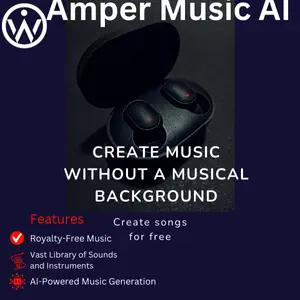
Python Prodigy
Dive into our review of Python Prodigy, a powerful annotation tool that streamlines your AI, ML, and NLP projects. Learn about its key features, real-world applications, and whether it’s the right fit for you. 🤔
Description
Python Prodigy Review: Is It the Annotation Tool You Need?
Alright, folks, let’s talk about Python Prodigy! 🎉 If you’re knee-deep in the world of AI, Machine Learning, or Natural Language Processing, you know that high-quality training data is the name of the game. But collecting and annotating that data? 😩 It can be a real time-sink. That’s where Python Prodigy comes in. It’s designed to be a radically efficient annotation tool that helps you create custom AI systems faster and more effectively. Think of it as your personal data annotation sidekick, built to streamline your workflow and get you to those sweet, sweet model improvements quicker. It’s more than just a tool; it’s a Python package and library with a web application that you can customize to fit your specific needs. With Python Prodigy, you can mix and match front-end components with your own Python functions to create a truly tailored annotation experience that is both efficient and effective. It supports macOS, Linux, and Windows and can be installed on Python 3.8 and above. Plus, it’s fully scriptable and integrates seamlessly into Python-based data science workflows, making it a natural fit for many projects.
Key Features and Benefits of Python Prodigy
So, what makes Python Prodigy stand out from the crowd? Here’s a rundown of its top features and how they can benefit you:
- Active Learning: Prodigy uses active learning to select the most informative examples for annotation, saving you time and effort. Instead of sifting through mountains of data, it prioritizes the data points that will have the biggest impact on your model.
- Customizable Workflows: Tailor the annotation interface and workflow to your specific needs with Python scripting. This flexibility means you’re not stuck with a one-size-fits-all solution; you can create something that perfectly matches your project requirements.
- Streamlined Data Handling: Easily stream in data from various sources using Python generators and built-in API loaders. Prodigy supports multiple platforms, offering integrations with GitHub and other APIs. It saves to a SQLite database for quick retrieval.
- Rapid Iteration: Quickly iterate and train high-quality AI models using minimal examples, thanks to Prodigy’s efficient annotation process. It enables data scientists to rapidly iterate and train high-quality AI models using minimal examples, ensuring that your project stays on track and ahead of the curve.
- Support for Multiple Tasks: Prodigy supports tasks within machine learning, such as branches of Natural Language Processing, Computer Vision, and experiment design. It allows annotators to easily generate training and test data, so your project has quality resources.
How Python Prodigy Works (Simplified)
Using Python Prodigy might sound intimidating, but it’s actually quite straightforward! First, you’ll need to install it into your Python environment like any other library. The main way to interact with it is via the command line using the prodigy command, followed by the name of a recipe you want to run and optional settings. You kick things off by creating a recipe (a Python script) that defines your annotation workflow. This recipe specifies how data is loaded, preprocessed, and presented to the annotator. Once you have the recipe ready, you use the prodigy command in your terminal to start the annotation server. This command takes your recipe as input and launches a web interface where you can start annotating data. As you annotate, Prodigy saves your decisions to a database, allowing you to train your machine learning models with the annotated data. This cycle continues as you refine the model with more annotated data, making it an iterative process that improves model performance over time.
Real-World Use Cases for Python Prodigy
Let’s get down to brass tacks—how can you *actually* use Python Prodigy? Here are a few scenarios where I’ve found it incredibly helpful:
- Named Entity Recognition (NER) for Customer Support Chatbots: I used Prodigy to annotate a dataset of customer support conversations, identifying entities like product names, order numbers, and addresses. This helped train a chatbot to understand customer requests more accurately.
- Image Classification for E-commerce Product Catalogs: I worked on a project where we needed to classify images of products in an e-commerce catalog. Prodigy allowed us to quickly annotate thousands of images, which significantly improved the accuracy of our image classification model.
- Sentiment Analysis for Social Media Monitoring: When tasked with analyzing sentiment towards a brand on social media, Prodigy helped annotate tweets and posts with sentiment labels (positive, negative, neutral). This allowed us to train a sentiment analysis model that provided valuable insights into brand perception.
- Text Classification for Spam Detection: We needed to build a spam detection system for email. Using Prodigy, we labeled a large dataset of emails as either spam or not spam, training a robust classifier.
Pros of Python Prodigy
- Radically efficient annotation
- Highly customizable workflows
- Seamless integration with Python
- Active learning saves time
- Supports multiple machine learning tasks
Cons of using Python Prodigy
- Requires a paid license 💰
- Steeper learning curve compared to simpler annotation tools
- Can be overkill for very small projects
Python Prodigy Pricing
Unfortunately, I don’t have access to the exact, up-to-the-minute pricing details for Python Prodigy. However, as it is a commercial product, it does require a paid license. You’ll want to head over to their official website (prodi.gy) to check out their current pricing plans and see which one best fits your needs and budget. Typically, annotation tools like Python Prodigy offer various licensing options, such as individual licenses, team licenses, and enterprise licenses, with pricing varying accordingly.
Conclusion
So, is Python Prodigy worth the investment? 🤔 If you’re serious about building custom AI systems and need a powerful, efficient annotation tool, then absolutely. Its active learning capabilities, customizable workflows, and seamless Python integration can significantly speed up your development process. However, if you’re just starting out or have very small annotation needs, you might want to explore free or open-source alternatives first. But for professionals and teams working on complex AI projects, Python Prodigy is a game-changer. Try it out and see how it can revolutionize your machine learning workflows!





Reviews
There are no reviews yet.